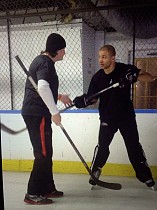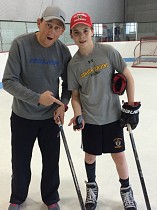 Dr. Shot, Glen Tucker, fires a shot at his Shoot to Score Shooting Academy in Waltham
Dr. Shot, Glen Tucker, fires a shot at his Shoot to Score Shooting Academy in Waltham
By MATT KALMAN | BOSTON HERALD October 23, 2014  
WALTHAM - Heading into this season, 37 - year-old Bruins defenseman Zdeno Chara had scored more than 150 goals and once had his slap shot clocked at 108.8 miles per hour.  
Chara, though, always is open to anything that will make him a better player.  So he sought out a little medicine from a man affectionately known as Dr. Shot.
Through his Shoot to Score program, Glen Tucker, 44, has helped dozens of future NHL stars on their way up to the big leagues.  He continues to aid many ofthem, and newcomers, at the STS facility and on the road.
In recent months, several Bruins, including Chara, Patrice Bergeron, Daniel Paille and Chris Kelly have reaped the rewards of working with Tucker.  In addition to back, arm and shoulder position that can improve a shooter's mechanics, Tucker focuses on a player's wrists and what he calls a "twitch" that sacrifices power for quickness and accuracy.
"My philosophy is shoot from the most uncomfortable position, in the most high-traffic area with the least amount of time," said Tucker, a father of five who lives in Bedford. "If you can shoot a puck in those three positions, you're going to be successful. It's the ones that think shooting is like golf, where you have time to fix your hair and tuck your shirt in, and you don't. So I think when players see, when people see the small players shoot pucks really well without heavy strength and weight, that's where I'm a big believer in."
A recent example was Chara's goal from the top of the left circle on Saturday in Buffalo, where the captain didn't load up for a rocket shot and the puck eluded several bodies before landing in the back of the net.
"It gives you a…different look and something at different times and places on the ice you can use," Chara said. "And if you get used to it, it's a great tool.
"A lot of times you're using, obviously, he likes to call it the twitch, and it does a lot. That little twitch can speed up the whole process of releasing the puck by a split second, which is a lot in hockey. Because you can release the puck way quicker and get it to the place. It doesn't have to be hard, but it's going to get there earlier."
Originally based in his native Canada, where he worked with the likes of P.K. Subban and John Tavares before they were NHL stars, Tucker first started working in the Bay State after student Matt Price joined Boston College in 2006 and helped the Eagles win two NCAA titles. Word of mouth spread, and a year and a half ago Tucker moved to the Boston area full-time.
Tucker's path to working with some of the Bruins came through Jarome Iginla, who despite having more than 500 career goals, when he joined the Bruins still wanted to improve his shot. Iginla saw Tucker working with his kids and the Boston Junior Eagles. A one-hour session with Tucker turned into two hours and 45 minutes (Tucker estimates about 1,500 shots fired), and Iginla became a fixture around Tucker's facility, which was originally in Woburn.
Fortuitously, Iginla scored twice in his next game on his way to a 30-goal season.
"After Jarome scored his first goal after being here with me, he said, ‘I never would have done that. I was skating this way when the net's that way. Any other time I would've stopped and tried to put my weight going forward,'" Tucker recalled. "But he said the first goal he was skating that way and he put a shot on net that way. So it's getting them to trust their body away from that comfort zone."
Throughout the season, Iginla learned from Tucker, and Iginla explained things to the coach about positioning and decision-making. Then Iginla spread the secret of Tucker's methods to his teammates.
"Jarome scores over 500 goals for a reason, so I just wanted to improve on certain things," Paille said. "And Glen has helped me kind of release my shot quicker in certain positions."
Paiile, who has hit the post twice this season with shots that might not have come as close to scoring without Tucker's twitch, said he feels like the tips Tucker gave him are becoming second nature. But it can be difficult to incorporate some of the concepts that alter the way you've been shooting for 15, 20 years even the slightest bit. Tucker's not trying to reinvent players' shots, just improve them through muscle memory. That's why a lot of the exercises he prescribes don't even involve a player being on the ice or synthetic surface at Shoot to Score. Players can stand next to a wall and touch their hands to it, or shoot while sitting on a box or with their leg up on the back of a chair.
Bergeron shared the team lead in goals with Iginla last season. That didn't stop him from summoning Tucker to Quebec during the summer for some lessons that are slowly seeping into the alternate captain's repertoire. "It's not something that's going to happen overnight, so I still have to work on it a lot and keep getting better," said Bergeron, whose only goal this season came on a quickly released, perfectly placed wrist shot. "But I'm sure over time it's going to become second nature. Obviously you do something for 20-something years and then something for one summer, you're going to go back to your old habit. But you still have to harp on it and work on it and it's going to come back."
Tucker's goal is to one day be the official shooting coach for an NHL team, particularly the Bruins. He's grown to love Boston, and he's still working with some of the best players in the area, including Minnesota Wild forward Charlie Coyle, Boston University draft prospect Jack Eichel, and 14-year old BU commit Jake Wise. He said he'll continue to work with the Bruins he's helped and any that want to give him a shot.
In a league in which parity rules and the slightest thing could make the difference between winning and losing, a shooting coach might be a wise hire.
"Even if you improve by five, 10, 15 percent, that's a lot," CHara said. "Because anything on the plus side is improvement."

 This past summer was my first as a professional hockey player, and Glen was a huge part of making it a successful one. Combining Glen's expertise with a workout, diet,... Read More »
This past summer was my first as a professional hockey player, and Glen was a huge part of making it a successful one. Combining Glen's expertise with a workout, diet,... Read More »











